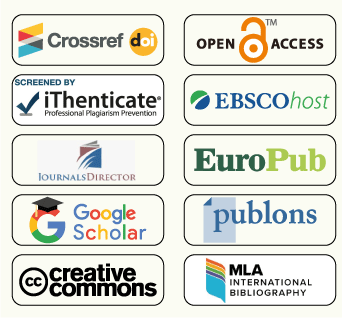Categorizing learners’ needs in English for occupational purposes (EOP): a proposed taxonomy
Abstract
Teaching English for Specific purposes (ESP) necessitates exerting tremendous efforts and carrying out tasks prior to the implementation of such courses. These tasks involve identifying learners’ needs and developing teaching material with specific discourse. The fact that learners are individuals with unique requirements should be considered, and here is where learning needs come into play. In addition to the learning environment, learning needs should take into account elements like motivation, strategies and skills. The aim of this study is to propose a categorization of learners’ needs during the implementation of ESP courses in professional contexts. To this end, the researchers employed a sequential exploratory research design hypothesizing and constructing a taxonomy that included four different dimensions of learners’ needs: language, cognitive, psychological and environmental. This was operationalized through an observation process conducted at a Cardiac Care Centre in Aswan, south of Egypt during EOP courses for nurses. To measure learners’ perceptions towards the proposed taxonomy, a questionnaire was disseminated to cardiac care nurses. Preliminary findings have revealed that the responses of the participants (n=94) were positive towards the proposed taxonomy of EOP learners’ needs. Based on the findings of the study, it is recommended that ESP instructors take into consideration cognitive, psychological and environmental needs alongside the language needs of learners prior to and during the implementation of ESP courses.
Keywords
Full Text:
PDFReferences
Alhadiah, A. (2021). Communicative needs of Saudi EFL engineering students in an EAP context: Task-based needs analysis. TESOL International Journal, 16(1).
Anthony, L. (2018). Introducing English for specific purposes. In Introducing English for Specific Purposes. https://doi.org/10.4324/9781351031189
Aprianto, D. (2020). NEED ANALYSIS IN ENGLISH LANGUAGE LEARNING (ELL) CURRICULUM DEVELOPMENTS. Jo-ELT (Journal of English Language Teaching) Fakultas Pendidikan Bahasa & Seni Prodi Pendidikan Bahasa Inggris IKIP, 3(2). https://doi.org/10.33394/jo-elt.v3i2.2431
Brindley, G. (1989). The role of needs analysis in adult ESL programme design. In The Second Language Curriculum (pp. 63–78). Cambridge University Press. https://doi.org/10.1017/CBO9781139524520.007
Chemir, S., & Kitila, T. (2022). Learners’ needs analysis for English for academic purposes in ethiopian higher education institutions: The case of Wachemo University freshman students. Cogent Education, 9(1). https://doi.org/10.1080/2331186X.2022.2026190
Gozali, A. (2018). Needs analysis on developing a syllabus of English for the study program of development economics universitas Brawijaya. Education of English as a Foreign Language, 1(2), 20–29. https://doi.org/10.21776/ub.Educafl.2018.001.02.03
Hafner, C. A., & Miller, L. (2018). English in the disciplines: A multidimensional model for ESP course design. In English in the Disciplines: A Multidimensional Model for ESP Course Design. https://doi.org/10.4324/9780429452437
Ibrahim, M. A. S. E. (2016). ESP needs analysis: A case study of PEH students, Univeristy of Khartoum. Sino-US English Teaching, 13(12).
Khalid, A. (2016). Needs Assessment in ESP: A Review. Studies in Literature and Language, 12(6).
Kothalawala, Kothalawala, T. D., & Amaratunga, W. (2015). Tracing the Development of Approaches of Needs Analysis in English for Specific Purposes (ESP). Ir.Kdu.Ac.Lk. http://ir.kdu.ac.lk/handle/345/1412
Meunchong, W. (2023). English for Homestay Tourism: Barriers and Needs of Entrepreneurs in Rural Community of Thailand. Theory and Practice in Language Studies, 13(2). https://doi.org/10.17507/tpls.1302.23
Needs Analysis. (n.d.). https://training.lbl.gov/Resources/NeedsAnalysis.html
Otilia, Simions, & Minodora. (2012). Needs analysis in English for specific purposes. Annals - Economy Series, 54-55.
Pranoto, B. E., & Suprayogi, S. (2020). A Need Analysis of ESP for Physical Education Students in Indonesia. Premise: Journal of English Education, 9(1). https://doi.org/10.24127/pj.v9i1.2274
Rahman, M. (2015). English for Specific Purposes (ESP): A Holistic Review. Universal Journal of Educational Research, 3(1). https://doi.org/10.13189/ujer.2015.030104
Yuriatson Jubhari, Rosmiaty, & Nurliah. (2022). Needs Analysis in English for Specific Purposes (ESP) for Nursing Students. EDULEC : Education, Language, and Culture Journal, 2(1). https://doi.org/10.56314/edulec.v2i1.31
DOI: http://dx.doi.org/10.21622/ILCC.2024.04.2.954
Refbacks
- There are currently no refbacks.
Copyright (c) 2024 Amr Selim Wannas, Inas Hussein Hassan

This work is licensed under a Creative Commons Attribution-NonCommercial 4.0 International License.
Insights into Language, Culture and Communication
E-ISSN: 2812-491X
P-ISSN: 2812-4901
Published by:
Academy Publishing Center (APC)
Arab Academy for Science, Technology and Maritime Transport (AASTMT)
Alexandria, Egypt
ilcc@aast.edu

